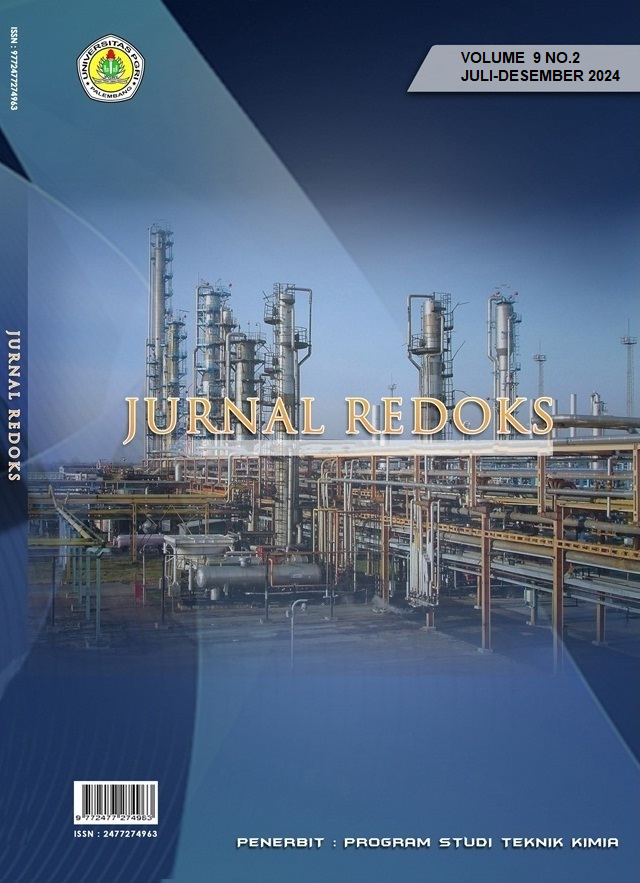Sifat Termal Dan Antibakteri Busa Komposit Poliuretan Kaku Dengan Pengisi Zeolit Alami Dan Daun Cengkeh
DOI:
https://doi.org/10.31851/redoks.v9i2.18321Keywords:
poliuretan, zeolit, komposit, daun cengkeh, sifat termal, morfologiAbstract
Penelitian ini bertujuan untuk mengembangkan komposit busa poliuretan (PU) yang memiliki sifat antibakteri dan ketahanan termal yang baik, dengan menambahkan serbuk daun cengkeh dan zeolit alam sebagai bahan pengisi. Daun cengkeh dipilih karena kandungan senyawa fenolik, seperti eugenol, yang memiliki aktivitas antibakteri, sedangkan zeolit alam ditambahkan untuk meningkatkan ketahanan termal komposit. Komposit PU dengan variasi konsentrasi daun cengkeh (1%, 1,5%, dan 2%wt) dan zeolit (10%, 20%, 30%wt) diproduksi dan dianalisis menggunakan FTIR, DSC, serta uji antibakteri terhadap Escherichia coli dan Staphylococcus aureus. Tujuan utama penelitian ini adalah untuk mengevaluasi pengaruh penambahan daun cengkeh dan zeolit terhadap sifat antibakteri dan termal komposit PU, serta menentukan komposisi optimal yang memberikan keseimbangan antara performa antibakteri dan ketahanan termal. Hasil penelitian menunjukkan bahwa penambahan daun cengkeh dapat meningkatkan aktivitas antibakteri komposit PU, dengan konsentrasi optimal pada 1%wt. Penambahan zeolit meningkatkan ketahanan termal komposit PU, dengan komposit yang mengandung 20% dan 30% zeolit menunjukkan kestabilan termal yang lebih baik dibandingkan komposit tanpa zeolit. Komposit PU yang diperkaya dengan daun cengkeh dan zeolit memiliki sifat antibakteri yang efektif dan ketahanan termal yang tinggi, menjadikannya sebagai alternatif bahan insulasi ramah lingkungan untuk berbagai aplikasi industri, terutama dalam bidang konstruksi dan pengemasan.
References
Apostolopoulou-Kalkavoura, V., Munier, P., & Bergström, L. (2021). Thermally Insulating Nanocellulose-Based Materials. Advanced Materials, 33(28). https://doi.org/10.1002/adma.202001839
Ashida, K. (2006). Polyurethane and related foams: chemistry and technology. CRC press.
Barczewski, M., Kurańska, M., Sałasińska, K., Michałowski, S., Prociak, A., Uram, K., & Lewandowski, K. (2020). Rigid polyurethane foams modified with thermoset polyester-glass fiber composite waste. Polymer Testing, 81, 106190. https://doi.org/10.1016/j.polymertesting.2019.106190
Cornille, A., Guillet, C., Benyahya, S., Negrell, C., Boutevin, B., & Caillol, S. (2016). Room temperature flexible isocyanate-free polyurethane foams. European Polymer Journal, 84, 873–888.
Dworakowska, S., Bogdał, D., Zaccheria, F., & Ravasio, N. (2014). The role of catalysis in the synthesis of polyurethane foams based on renewable raw materials. Catalysis Today, 223, 148–156. https://doi.org/10.1016/j.cattod.2013.11.054
Gultom, F., Wirjosentono, B., Thamrin, Nainggolan, H., & Eddiyanto. (2016). Preparation and Characterization of North Sumatera Natural Zeolite Polyurethane Nanocomposite Foams for Light-weight Engineering Materials. Procedia Chemistry, 19, 1007–1013. https://doi.org/10.1016/j.proche.2016.03.150
Gultom, G., Wirjosentono, B., Ginting, M., & Sebayang, K. (2017). Effects of natural zeolite and ferric oxide to electromagnetic and reflection loss properties of polyurethane nanocomposite. IOP Conference Series: Materials Science and Engineering, 223(1). https://doi.org/10.1088/1757- 899X/223/1/012031
Ionescu, M. (2005). Chemistry and technology of polyols for polyurethanes. iSmithers Rapra Publishing.
Kosmela, P., Gosz, K., Kazimierski, P., Hejna, A., Haponiuk, J. T., & Piszczyk, Ł. (2019). Chemical structures, rheological and physical properties of biopolyols prepared via solvothermal liquefaction of Enteromorpha and Zostera marina biomass. Cellulose, 26(10), 5893–5912. https://doi.org/10.1007/s10570-019-02540-8
Kurańska, M., Barczewski, M., Uram, K., Lewandowski, K., Prociak, A., & Michałowski, S. (2019). Basalt waste management in the production of highly effective porous polyurethane composites for thermal insulating applications. Polymer Testing, 76, 90–100. https://doi.org/10.1016/j.polymertesting.2019.02.008
Laurichesse, S., & Avérous, L. (2014). Chemical modification of lignins: Towards biobased polymers. Progress in Polymer Science, 39(7), 1266–1290.
Lelawati, Tonadi, E., & Aan Sefentry. (2023). Analisis Kekerasan Papan Komposit dari Serat Pelepah Pisang Dengan Resin Polyester. Jurnal Redoks, 8(2), 152–157. https://doi.org/10.31851/redoks.v8i2.13614
Li, Y. (2012). Application of cellulose nanowhisker and lignin in preparation of rigid polyurethane nanocomposite foams. Georgia Institute of Technology.
Olad, A., & Naseri, B. (2010). Preparation, characterization and anticorrosive properties of a novel polyaniline/clinoptilolite nanocomposite. Progress in Organic Coatings, 67(3), 233–238.
Pathirana, H., Wimalasena, S., De Silva, B. C. J., Hossain, S., & Heo, G. (2019). Antibacterial activity of clove essential oil and eugenol against fish pathogenic bacteria isolated from cultured olive flounder (Paralichthys olivaceus). Slov. Vet. Res, 56, 31–38.
Peyrton, J., & Avérous, L. (2021). Structure-properties relationships of cellular materials from biobased polyurethane foams. In Materials Science and Engineering R: Reports (Vol. 145). Elsevier Ltd. https://doi.org/10.1016/j.mser.2021.100608
PlasticsEurope, E. (2016). Plastics—The Facts 2019. An Analysis of European Plastics Production, Demand and Waste Data. Plast. Eur.
Querol, X., Moreno, N., Umaña, J. C. t, Alastuey, A., Hernández, E., Lopez-Soler, A., & Plana, F. (2002). Synthesis of zeolites from coal fly ash: an overview. International Journal of Coal Geology, 50(1–4), 413–423.
Rodrigues Pereira de Paula, C., Trianoski, R., & Azevedo, E. (2020). Development and characterization of sawdust and sisal fiber reinforced vegetable based polyurethane foam hybrid composites. Journal of Natural Fibers, 00(00), 1–10. https://doi.org/10.1080/15440478.2020.1841067
Safari, H., Karevan, M., & Nahvi, H. (2018). Mechanical characterization of natural nano-structured zeolite/polyurethane filled 3D woven glass fiber composite sandwich panels. In Polymer Testing (Vol. 67). Elsevier Ltd. https://doi.org/10.1016/j.polymertesting.2018.03.018
Scarfato, P., Di Maio, L., & Incarnato, L. (2017). Structure and physical-mechanical properties related to comfort of flexible polyurethane foams for mattress and effects of artificial weathering. Composites Part B: Engineering, 109, 45–52. https://doi.org/10.1016/j.compositesb.2016.10.041
Tahdid, T., Manggala, A., Wasiran, Y., Nurryma, I., Ramadhani, P. S., & Kobar, A. A. (2022). Pengaruh Jumlah Zeolit dan Temperatur terhadap Rendemen Bahan Bakar Cair Menggunakan Limbah Plastik di Unit Thermal Catalytic Cracking Reactor. Jurnal Redoks, 7(2), 26–32. https://doi.org/10.31851/redoks.v7i2.9269
Tran, P., Graiver, D., & Narayan, R. (2005). Ozone‐mediated polyol synthesis from soybean oil. Journal of the American Oil Chemists’ Society, 82(9), 653–659.
Triwulandari, E. N. A. ; H. (2014). Jurnal Sains Materi Indonesia SAWIT SEBAGAI BAHAN BAKU BUSA POLIURETAN. Jurnal Sains Indonesia, 16(1), 43–48.
Wang, S. X., Zhao, H. B., Rao, W. H., Huang, S. C., Wang, T., Liao, W., & Wang, Y. Z. (2018). Inherently flame-retardant rigid polyurethane foams with excellent thermal insulation and mechanical properties. Polymer, 153, 616–625. https://doi.org/10.1016/j.polymer.2018.08.068
Yang, L. T., Zhao, C. S., Dai, C. L., Fu, L. Y., & Lin, S. Q. (2012). Thermal and Mechanical Properties of Polyurethane Rigid Foam Based on Epoxidized Soybean Oil. Journal of Polymers and the Environment, 20(1), 230–236. https://doi.org/10.1007/s10924-011-0381-6
Downloads
Published
How to Cite
Issue
Section
License
Copyright (c) 2024 Erfina Oktariani, Krisna Bayu, Nerviani Nadari Rizkika, Herlin Arina

This work is licensed under a Creative Commons Attribution-NonCommercial 4.0 International License.










